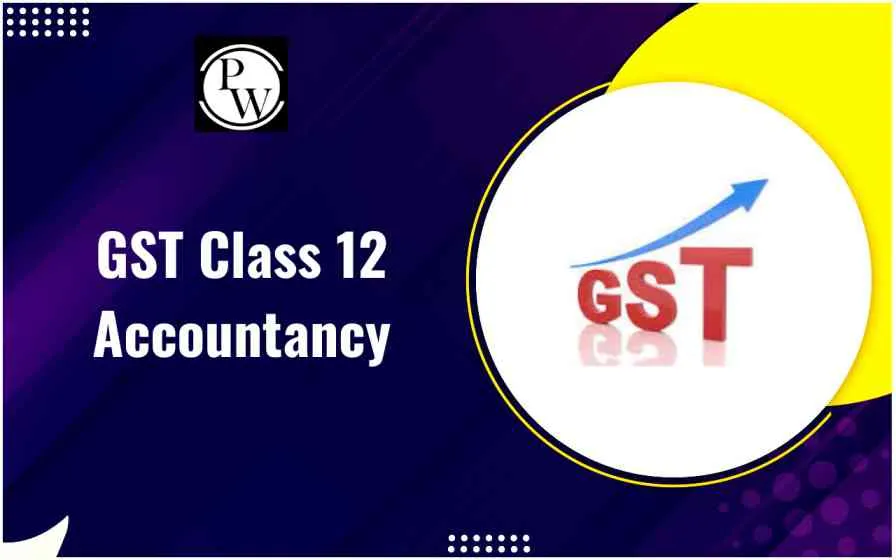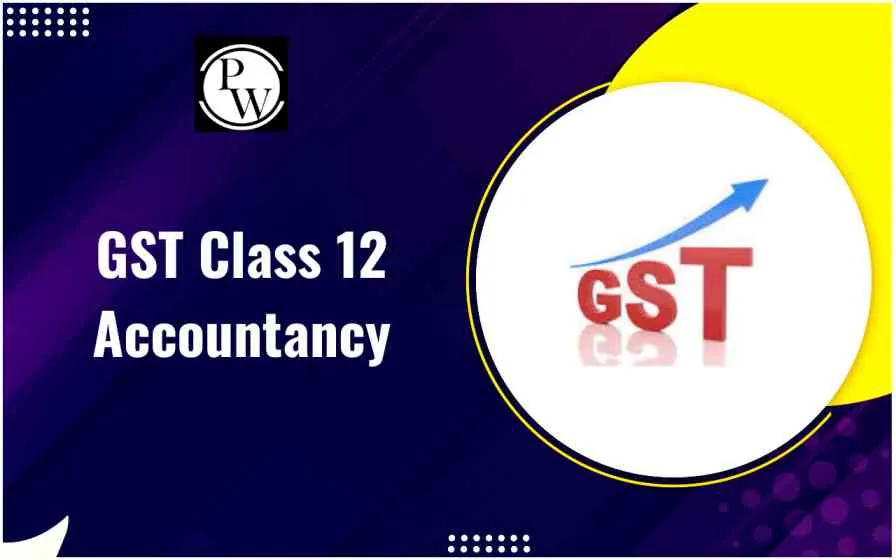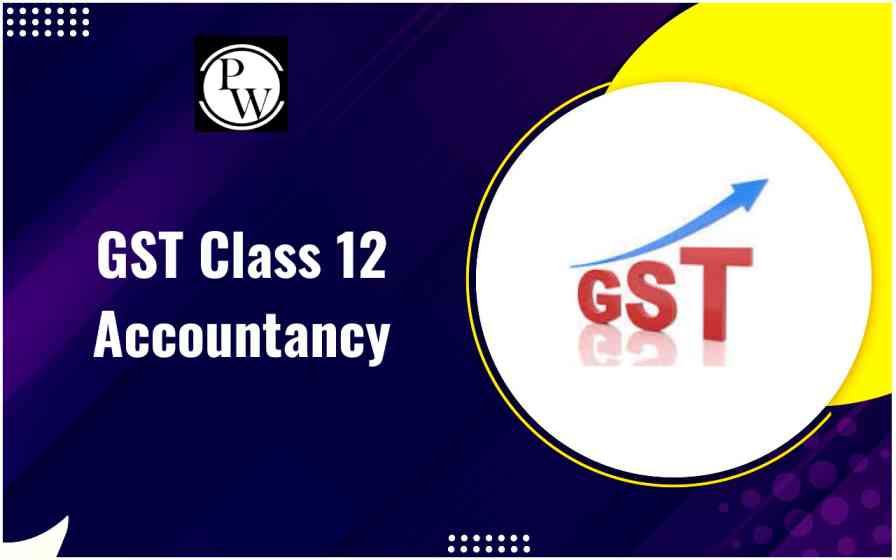

GST Class 12 Accountancy: Goods and Services Tax (GST) is one of the most important topics in Class 12 Accountancy. GST is an indirect tax that replaced many other taxes in India. It was introduced in July 2017 to simplify the tax structure. GST is considered a major reform in the Indian economy as it combines multiple taxes into a single system. For students of Class 12, understanding the basics of GST Class 12 Accountancy is essential because it forms the foundation for solving practical questions, such as the GST bill format and GST journal entries.
GST is collected at every stage of the supply chain. However, the final burden of tax is on the consumer. It helps in reducing confusion, saves time, and improves efficiency in taxation. Below, we’ve explained the meaning, types, and importance of GST Class 12 Accountancy simply and clearly.
What is GST Class 12 Accountancy?
GST Class 12 Accountancy refers to the study of Goods and Services Tax as part of the Class 12 Accountancy curriculum. It is taught to make students understand how indirect tax works in business transactions. GST is designed to make taxation uniform across India. Earlier, both central and state governments had their own tax rules. With GST, all taxes are merged into a single system.
GST is an indirect tax. This means the burden of tax is transferred from sellers or service providers to the buyers. For example: When goods are sold worth ₹1,00,000 with 18% GST, the entry will be:
|
Date |
Particulars |
L.F. |
Debit (₹) |
Credit (₹) |
|
xx/xx/xxxx |
Debtor A/c Dr. To Sales A/c To Output CGST A/c To Output SGST A/c (Sale of Goods with GST) |
1,18,000 |
1,00,000 9,000 9,000 |
|
Why was GST Introduced?
Before GST, India had different taxes at the state and central levels. For example, Excise Duty was charged by the central government, while VAT was charged by the state government. Service Tax was another separate tax. This made the taxation system very complex.
The introduction of GST made the system simple because now we pay only one kind of tax instead of many. GST also made the flow of goods and services between states smoother.
For students of GST Class 12 Accountancy, this background is important because exam questions often test the difference between the old taxation system and GST.
Types of GST Class 12 Accountancy
To make taxation simple and fair, GST is divided into four major types. Each type has its own use depending on the nature of trade.
1. Central Goods and Services Tax (CGST)
This tax is collected by the Central Government on goods and services supplied within the same state. It replaces central-level taxes like excise duty and service tax.
2. State Goods and Services Tax (SGST)
This tax is collected by the State Government on goods and services supplied within the same state. It replaces state-level taxes like the entertainment tax, luxury tax, and entry tax.
3. Integrated Goods and Services Tax (IGST)
This tax is collected by the Central Government when goods and services move from one state to another. The collected tax is then shared between the Centre and the concerned states.
4. Union Territory Goods and Services Tax (UTGST)
This tax is applied in Union Territories of India such as Delhi, Chandigarh, and the Andaman and Nicobar Islands. It ensures that trade in these regions is also covered under the GST system.
In Class 12 Accountancy, students study these types in detail. They also prepare the GST bill format and GST journal entries based on these types of GST.
Importance of GST
GST Class 12 Accountancy is not just about theory. It has real importance in business and the economy. Students must understand why GST is important.
1. Simplification of the Tax System
Earlier, businesses had to pay many types of taxes, like excise duty, VAT, service tax, and entry tax. GST replaced all these with one system. This makes it easier to calculate and pay taxes.
2. Transparency
With GST, every bill and transaction is recorded properly. This reduces the chances of corruption and ensures fair taxation. In Class 12 Accountancy, the use of gst bill format shows how GST brings transparency in recording.
3. Avoids Double Taxation
Before GST, sometimes the same product was taxed multiple times. For example, both excise duty and VAT were applied to a single product. GST removed this problem and ensured that tax is charged only once.
4. Encourages Business Growth
GST makes trade easier between states because there are no multiple taxes. It promotes a smooth supply of goods and services across India.
5. Learning for Students
GST Class 12 Accountancy helps students prepare for real business scenarios. They learn how to record GST journal entries and the GST bill format. These skills are helpful in higher studies and professional careers.
GST Journal Entries
As part of GST Class 12 Accountancy, students need to learn GST journal entries for different situations. Below, we’ve mentioned some examples:
Purchase of Goods with GST
|
Date |
Particulars |
L.F. |
Debit (₹) |
Credit (₹) |
|
xx/xx/xxxx |
Purchases A/c Dr. Input CGST A/c Dr. Input SGST A/c Dr. To Creditor A/c (Purchase of Goods with GST) |
Xxx Xxx Xxx |
Xxx |
|
Sale of Goods with GST
|
Date |
Particulars |
L.F. |
Debit (₹) |
Credit (₹) |
|
xx/xx/xxxx |
Debtor A/c Dr. To Sales A/c To Output CGST A/c To Output SGST A/c (Sale of Goods with GST) |
Xxx |
xxx xxx Xxx |
|
Payment of GST to the Government
|
Date |
Particulars |
L.F. |
Debit (₹) |
Credit (₹) |
|
xx/xx/xxxx |
Output CGST A/c Dr. Output SGST A/c Dr. To Bank A/c (Payment of GST to the Government) |
Xxx xxx |
xxx |
|
GST Bill Format
When GST is charged in a business transaction, the seller must issue a GST bill to the buyer. Understanding the GST bill format helps students of GST Class 12 Accountancy learn how business transactions are recorded properly. A GST bill format is very simple. Below, we’ve mentioned the GST Bill Format:
- Name, address, and GSTIN of the seller
- Name, address, and GSTIN of the buyer (if registered)
- Invoice number and date
- Description of goods or services
- Value of goods or services
- Rate of GST and total GST amount
- Signature of the seller
GST is one of the most important reforms in India’s taxation history. It is a simple and transparent system that replaced many different indirect taxes. For students of GST Class 12 Accountancy, understanding GST is not only important for exams but also useful for future studies in commerce and finance.
By learning GST, students can understand how bills are made, how journal entries are recorded, and how the government collects taxes. It is an essential part of the Class 12 syllabus and forms the base for higher studies in accountancy.
GST Class 12 Accountancy FAQs
What is GST in Class 12 Accountancy?
Why is GST important in Accountancy?
What are the types of GST?
What is the GST bill format?













